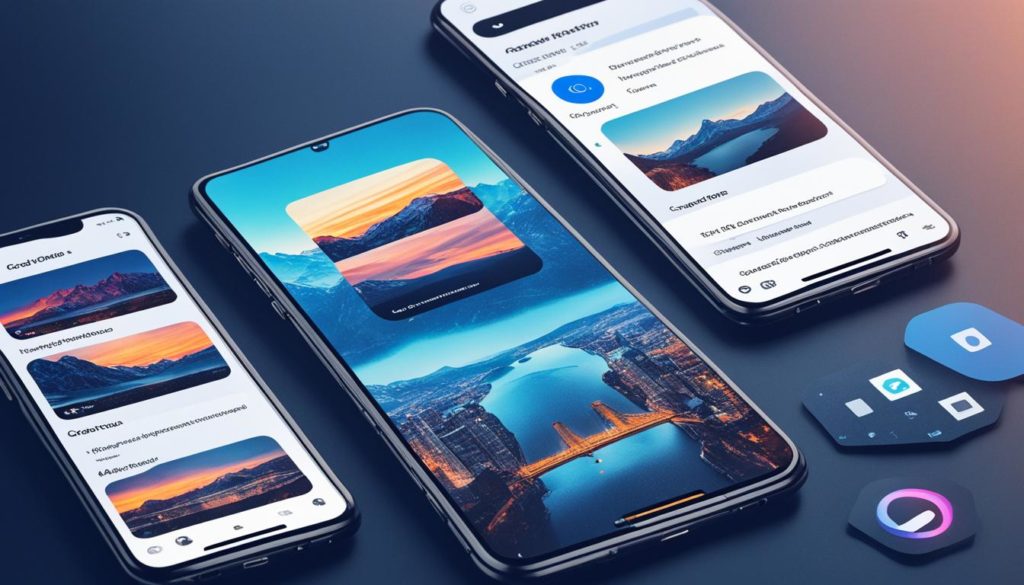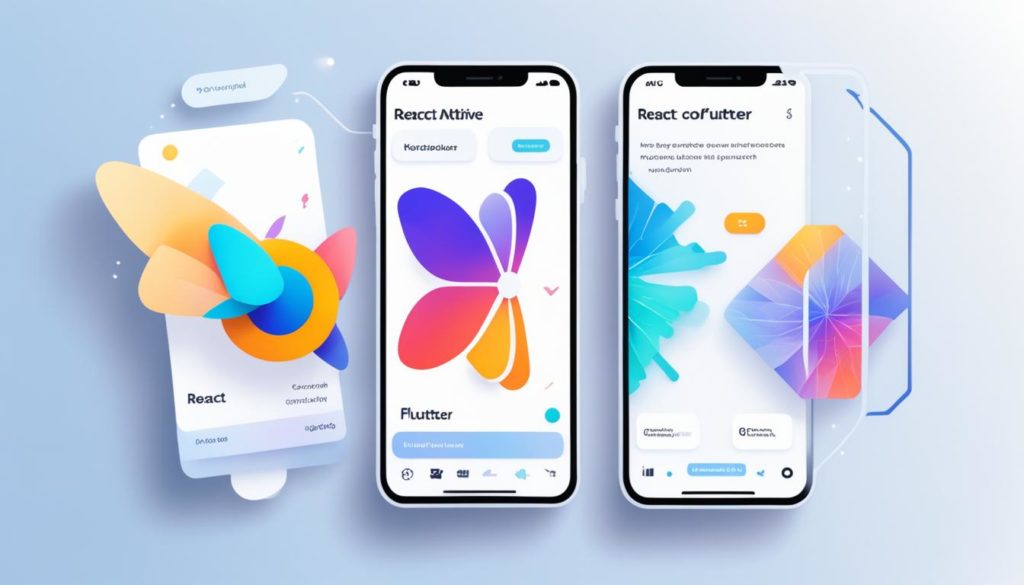
Flutter has over 310,507 questions on Stack Overflow, while React Native has about 89,638. This fact highlights how fast mobile app development is changing. When talking about React Native and Flutter, we’ll see what makes each special.
React Native and Flutter help build apps that work on both Android and iOS. Flutter was started by Google in 2017. It’s known for making apps that look native with just one code. React Native came from Facebook in 2015, using JavaScript. It’s great for fast building and has lots of components. As we look closer, we’ll see why these frameworks are top choices in mobile app development.
Key Takeaways
- React Native was launched by Facebook in 2015, while Flutter came from Google in 2017.
- Flutter has more tagged questions on Stack Overflow, indicating active developer engagement.
- React Native’s widespread adoption is fueled by its use of JavaScript, whereas Flutter uses Dart.
- Flutter apps tend to be larger in size due to their single code base approach.
- React Native supports a minimum SDK version of 21, while Flutter can run on Android 4.1 with a minimum SDK version of 16.
- Flutter’s documentation is streamlined compared to React Native’s, aiding in ease of use.
Introduction to Cross-Platform App Development
In today’s world, cross-platform app development is changing the game. It lets developers make apps that work on different systems, like Android and iOS, using one codebase. This method is very efficient. It saves a lot of time and resources. This is because developers don’t have to write new codes for each platform. Now, about half of all mobile app projects in 2023 use cross-platform frameworks. This shows how important it is.
What is Cross-Platform App Development?
Cross-platform app development uses tools like Flutter and React Native. It builds apps that work well on various systems. These frameworks let developers use the same libraries and tools. This helps keep the code consistent and cuts down on development time. For instance, Flutter can be used on many platforms such as Android, iOS, Windows, macOS, and Linux. React Native also supports a range of platforms.
Why Consider Cross-Platform Frameworks?
Choosing cross-platform frameworks has many benefits. They offer strategic and financial advantages. First, they allow products to reach the market faster. This speed is key in a competitive environment. With ready-made UI components and hot, tools like Flutter and React Native can speed up design and launch. They also help maintain a consistent user experience. This is due to their adaptable and system-specific design features.
Plus, maintaining and updating cross-platform apps is easier. For example, Flutter uses automated tools for simple upkeep. This means the apps stay current with less hassle. This is different from native apps. Updating those can require a lot more work for each operating system.
Finally, don’t forget about the strong community support and detailed guides for these frameworks. Flutter has gotten 162k stars on GitHub by May 2024, while React Native has 116k stars. These numbers show their popularity and the resources available for developers.
Cross-platform app development can help businesses and developers make better choices. In the end, it leads to apps that are more efficient, cost-effective, and successful.
Understanding React Native and Flutter
Mobile app frameworks like React Native and Flutter have distinct traits and stories. They both boost the growth of apps that work on multiple platforms. They also offer different features and tools.
What is React Native?
React Native is a tool made by Facebook. It lets coders make apps for both Android and iOS with just one set of code. It’s known for making parts of the app look like they belong on the device they’re on.
What is Flutter?
Google created Flutter, a toolkit for building apps that look native on phones, the web, and computers. It uses Dart, making app development smoother. Flutter also has a big collection of ready-to-use widgets and tools.
History and Evolution
The growth of React Native and Flutter is both interesting and quick. Facebook launched React Native in 2015, leading to more cross-platform apps. It became popular for its use of JavaScript and native feel.
Google introduced Flutter in 2017, adding to the ideas React Native started. Flutter brought new things like a full set of widgets and the Dart language. Both frameworks keep getting better, making app development easier, cheaper, and more powerful.
| Framework | Developer | Release Year | Programming Language |
|---|---|---|---|
| React Native | 2015 | JavaScript | |
| Flutter | 2017 | Dart |
React Native vs Flutter: Performance Comparison
React Native and Flutter both shine in different ways when it comes to performance. Each has unique aspects that fit various project needs. This makes them stand out based on what’s required for specific apps.
Performance Metrics of React Native
React Native communicates between JavaScript and native parts through a bridge. This can heavily use the CPU because of the JSBridge. For instance, React Native uses more CPU than native apps. This means it can use more power and reduce battery life.
On devices like iPhone 6s, React Native might show lower FPS because it doesn’t use IoT compilation on iOS. Despite these issues, it offers a large selection of UI kits and libraries. These tools help create beautiful UIs that make apps feel smooth and integrated on any platform.
Performance Metrics of Flutter
Flutter takes a different route by compiling Dart code into native ARM code. This approach offers great performance for demanding tasks. Though it uses memory almost as efficiently as Android Native, it pushes the CPU harder, especially on devices like iPhone 6s.
When it comes to starting apps, Flutter is ahead, launching apps faster than both Android Native and React Native. Its hot reload feature changes the development game by updating apps instantly. But, it does require more memory, particularly with heavy animations.
UI Design and User Experience
In designing user interfaces, both React Native and Flutter excel but in different ways. React Native benefits from a strong community and a wide range of libraries. It’s great for creating complex animations and interactive elements using native rendering.
Flutter, on the other hand, uses its own widgets for a highly customizable design. This gives developers the freedom to craft unique and engaging UIs with smooth performance.
When we compare them, React Native and Flutter each have key strengths. Your specific project needs should guide your choice between them. This ensures you pick the framework that fits your app’s goals best.
- Native development shines with platform-specific optimization and access to the latest OS features.
- The vast community behind React Native enriches it with libraries and plugins.
- Flutter stands out with its fast hot reload and flexible design through customizable widgets.
Community Support and Documentation
Choosing a mobile app development framework often depends on the developer community’s strength. These communities are crucial for finding solutions and support. Let’s look into the community and documentation of React Native and Flutter.
React Native’s Developer Community
Facebook has supported React Native since 2015. It boasts a vast, active developer community. Its popularity shows in many online discussions, especially on Stack Overflow.
The use of JavaScript invites many web developers. React Native’s documentation and development kits are top-notch. Plus, new updates like the JSI bridge module keep the community growing and engaged.
Flutter’s Developer Community
Flutter might be newer since Google launched it in 2017, but it’s catching up fast. Google’s backing and detailed documentation have built a strong community. Google Trends showed Flutter surpassing React Native in search popularity by 2020, an interest that continues until 2023.
The new Impeller engine boosts app performance, enhancing Flutter’s allure. Such improvements signal Flutter’s important role in app development and its promising trajectory.
Ease of Finding Solutions
React Native and Flutter are both great at solving problems, but in different ways. React Native’s vast JavaScript ecosystem speeds up development. The community and documentation make it user-friendly.
Though newer, Flutter has organized documentation and Google’s full support. This draws more developers to prefer it. Moreover, a 2020 Statista survey showed Flutter and React Native neck-and-neck in developer use worldwide. Google’s update to Flutter 2, adding web support and targeting multiple OS, broadens its appeal.
- React Native benefits from its vast JavaScript community and robust libraries.
- Flutter’s rapid documentation growth and strong community support offer substantial mobile app development support.
- Both frameworks enable developers to find solutions easily, assisting in smoother and more efficient app development cycles.
| Aspect | React Native | Flutter |
|---|---|---|
| Initial Release | 2015 | 2017 |
| Primary Language | JavaScript | Dart |
| Backing Company | ||
| Most Popular | Stack Overflow 2022 | Google Trends 2023 |
| Rendering Engine | JSI (JavaScript Interface) | Impeller |
| Ease of Finding Solutions | Extensive discussions, robust libraries | Strong documentation, growing community |
Conclusion
Choosing between React Native and Flutter involves several key factors. These range from performance to the developer community’s support. React Native is great for teams wanting a well-known JavaScript base and strong community aid. Flutter, though, offers quick performance and a growing community with its Dart foundation.
To make a choice, we need to think about our team’s skills and what our project needs. If we want to start quickly and solve problems easily, React Native is likely the better option. But, if we’re aiming for a scalable app with creative designs, Flutter might be what we need.
In the end, both React Native and Flutter give us powerful tools for building cross-platform apps. By weighing our current needs against future goals, we can pick the best framework. This framework will help speed up our development and make users happy.
FAQ
What is Cross-Platform App Development?
Cross-platform app development lets you create apps that work on Android and iOS with one codebase. It makes development faster and cheaper. You don’t need different codes for different platforms.
Why Consider Cross-Platform Frameworks?
Cross-platform frameworks like React Native and Flutter use one set of tools for both Android and iOS. This leads to a consistent experience across devices. And, it helps products reach the market faster.
What is React Native?
React Native, created by Facebook in 2015, is a framework for building native-like mobile apps using JavaScript. It connects to native components for a smooth experience on Android and iOS.
What is Flutter?
Flutter is a toolkit from Google for building apps that run natively on mobile, web, and desktop. Launched in 2017, it uses Dart. Flutter is praised for its speed, ease, and rich widgets.
What are the Performance Metrics of React Native?
React Native interacts with native components using a bridge. This can sometimes reduce speed. But, it offers native elements and UI kits for a great user experience.
What are the Performance Metrics of Flutter?
Flutter connects directly to native components which boosts its performance. Its unique widgets enable customized designs and smooth running of apps.
How do React Native and Flutter compare in terms of UI Design and User Experience?
React Native uses JavaScript and UI kits for a native look. Flutter allows for more design freedom with its widgets. This gives consistent UI designs across platforms.
What is React Native’s Developer Community like?
React Native’s developer community is large and helpful. It offers lots of documentation and tools. Its JavaScript base makes it a favorite among developers.
What is Flutter’s Developer Community like?
Flutter’s community is growing and strong. It has good documentation despite being newer. Its performance and Dart language attract developers.
How easy is it to find solutions for React Native and Flutter?
Both have supportive communities making it easy to find help. React Native benefits from its presence on platforms like Stack Overflow. Flutter, though newer, has a vast array of resources and community support.
Future App Studios is an award-winning software development & outsourcing company. Our team of experts is ready to craft the solution your company needs.










